-

-

An example from demonline (UCT Physics Department’s website with descriptions of educational demonstrations). Its description reads: ‘A lodestone is suspended by a string. Show that it rotates on bringing a magnet near it. Dip it into iron filings and show that it picks them up.’
-

"The figure of ‘Mrs Glover’, kneeling and treating what appears to be a very ill man, exudes not only the authority of Western medicine within the local context but conveys her as the self-sacrificing and caring European ‘civilizer’ in service of expanding the empire, ‘the medicine chest conveniently by her side’ (Johnson 2008b: 259)" (Liebenberg 2021: 63 - 65).
-

"The chest was featured in a work titled 'Hoard', for which Bloch sculpted in clay the objects in the UCT collection as well as ones from the 11th century Mapungubwe collection (housed at the University of Pretoria). She painted these sculpted objects gold and presented them in museum display cases, drawing attention to the arbitrary nature of objects’ value and to the possibility that historically loaded items can be accidentally overlooked and misevaluated (Bloch in Honigman 2014: online)" (Liebenberg 2021: 82 - 84).
-

Flight patterns observed on a bus en route back to London from Oxford on a research trip in 2017.
-
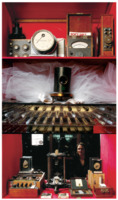
"Strategies such as juxtapositioning also served to highlight poetic and emotive qualities in fields not known for encouraging them, as in a cabinet curated by Langerman titled Capitance. This featured a range of instruments from the Physics department used to measure electrical currents (galvanometers, capacitors and Wheatstone bridges); a crystal goniometer measuring crystal face angles and crystal 175 from the crystal collection in Geological Sciences; M.R. Drennan’s models of the human embryo and a wax model of flesh; and a white tutu from the School of Ballet. In combining this selection of scientific instruments with a tutu, Langerman made allowance for the materials to be considered in a more poetic light, inviting the viewer to consider how a grand jeté defies the laws of physics, for example" (Liebenberg 2021: 186).
-

"In 'Similitude', Langerman brought together a selection of objects from three disparate disciplines – glassware from chemical engineering; a skull with an arrow embedded in it and a torch used as a murder weapon from forensic pathology; and two flutes from the Kirby collection. Ignoring the assigned functions the objects performed within their respective disciplines, she chose instead to use their formal characteristics as a taxonomic device. They were all, as she described them, ‘long thin things’ (Langerman n.d.). In displacing these objects from their respective disciplines and positioning them in proximity to objects that shared this new category, she neutralised their disciplinary functions and flattened their meanings within those fields (Langerman n.d.)" (Liebenberg 2021: 183).
-

"A stainless-steel dilator from the Drennan collection, a carded set of glass slides of xenopus heart sections from the Medical Microbiology collection, a 19th century game called 'Frogs and Toads' from Special Collections and a wax model of an embryo, also from Drennan. This ‘amphibian’-inspired display showcases many qualities of the curatorial method, such as visual quotation (the combination of these materials foregrounds that the shape of the dilator resembles a frog), analogy (the wax embryo, dilator and frogs allude to the resemblance between sperm and tadpoles) and juxtaposition (the frog as a scientific topic dissected and contained in the slides, and the frog as a board piece in a game played by children)" (Liebenberg 2021: 183).
-

My copy of Ndebele’s 'Fools and other stories', read and underlined in 2001.
-

"At the opening of the Archive and Archive and Public Culture programme (APC) in 2009, Prof. Ndebele stated that ‘there can be no transformation of the curriculum, or indeed of knowledge itself, without an interrogation of archive’, a call which both the Centre for Curating the Archive and the APC have sought to answer by producing scholarship that questions and expands what we understand as ‘archive’ and its relevance in a South African context and in an African university (Skotnes 2019: 21)" (Liebenberg 2021: 195).
-

WHERE THE WILD THINGS ARE:
An Honours in Curatorship Hiddingh Campus field study
Curated by Nina Liebenberg
21 OCTOBER – 5 NOVEMBER 2014
'Where the Wild Things Are' explored the political, social and historical narratives embedded in the natural world through investigation, observation, mapping, archival research and art making.
The exhibition consisted of various on-site interventions engaging with contemporary and historical spatial dynamics and the significance of Hiddingh Campus. The Egyptian Building (home to sculpture workshops and studios) was built on the site of a zoo established in the late eighteenth century that was replete with lion’s dens and a small lake that supposedly housed a hippo. The campus was also the home to UCT’s first Zoology and Botany building (now the Michaelis Building). This historical perspective highlights both the site’s colonial imprints and its early affiliation with the sciences. The UCT campus is divided into its main upper campus, a middle and lower campus, and a few satellite campuses, of which the Michaelis School of Fine Art and the South African College of Music form part.
Students drew on the methodologies of artist/curator Mark Dion, collaborating with specialists from upper campus (entomologists, ornithologists and botanists) and Michaelis Fine Art students, to highlight its natural environment.
The interventions occurred on different days, and over a two week period. A calendar was provided to stipulate event times and artwork appearances.
Participating artists: Christopher Swift, Dillon Marsh, Fritha Langerman, Thuli Gamedze, Pippa Skotnes, Alex Kaczmarek, Rone-Mari Botha, Jessica Holdengarde, Fanie Buys, Lara Reusch, Stephani Muller, Tegan Green, Evan Wigdorowitz, Mariam Moosa, C J Chandler, Adrienne Van Eeden-Wharton
-

A selection of glass slides of the insects, ticks and worms that are the primary or intermediate hosts or carriers of human diseases. These slides also featured in the 'Curiosity CLXXV' and 'Subtle thresholds' exhibitions, sourced from the Pathology Learning Centre (PLC), where they were originally donated by the secretary of the Department of Microbiology. Dr Yeats identified them as glass photomicrographs and speculated that they were probably made for a special projector used for teaching many years ago.
-

"The large quantity of papers in the BC666 collection pertaining to dental matters – which includes ‘legal and financial papers of the dental practice, papers of the various dental societies to which Walter belonged from 1905 to 1934’ and letters on various dental matters, as well as a large section devoted to correspondence, memoranda and notes on the Medical, Dental and Pharmacy Act of 1928 – shows he was ‘very active in dental politics’ (Hart & Lydall 1981: 1). As an 'office-bearing member of the Dental Society of the Cape Province, and a member of the South African Dental Association, he was the key figure in formulating and presenting the dentists’ case against unqualified dental mechanics in the proposed new medical bill, which was passed in 1928 as the Medical, Dental and Pharmacy Act' (Hart & Lydall 1981: 1).
This act was considered a milestone in the development of organised medical, dental and pharmaceutical practices in South Africa, establishing a single set of regulations for these professions across the country (Ryan 1986: 149–151). It was also, however, one of a series of laws passed in South Africa that have regulated indigenous medical practices since the 19th century. Legislation passed in 1862 prevented sangomas from practicing (Paarl in Bishop 2010: 14), and the 1928 act barred inyangas from practicing in all parts of the country except Natal, where they could continue to practice if granted a license (Flint in Bishop 2010: 14–15). The act also banned the indigenous use of ‘European’ methods of diagnosis and treatment, for example forbidding the use of stethoscopes by inyangas (Bishop 2010: 16)" (Liebenberg 2021: 53 - 55).
-

Part of the ‘Useful plants’ section at Kirstenbosch National Botanical Garden.
-
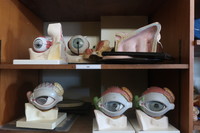
Educational models found in the Anatomy workshop:
"Borrowing from Herbert Read’s art historical discussion on looking, Digby posits that the biomedical practitioner’s generally critical attitudes were shaped in part by their limited recognition of indigenous medicine during this period – ‘what we see is inseparable from how we see; the eye is not innocent, and vision is partial’ (Digby 2006: 356) and, quoting Read, ‘we see what we learn to see, and vision becomes a habit, a convention, a partial selection of all there is to see’ (in Digby 2006: 356). Accordingly, Digby argues that the Western practitioners would have had, at best, only a partial view of the different medical systems in South Africa during this period (Digby 2006: 357) and probably only to the extent that it was a threat to their own livelihood and authority – as evidenced in the 1928 Medical, Dental and Pharmacy Act that Floyd helped instate" (Liebenberg 2021: 55).
-

A drawer of rattles in the South African College of Music's Kirby collection:
"The instruments are now grouped in different cabinets according to the taxonomy set out by Kirby in his book. In the preface to the second edition (1964), Kirby shares some of his considerations when deciding how to group the instruments, writing that he had to decide ‘whether to arrange his material tribally, or to deal with each type of musical instrument separately from the technological and historical points of view, allowing the tribal aspects to emerge incidentally’ (Kirby 1964: xi). Kirby chose the second alternative, stating that his chief reason was that he wanted the work to be, as far as possible, ‘a complete and comparative study of one particular aspect of the life of our aborigines’ (1964: xi).
His second consideration was to find the most suitable manner for classifying the instruments, for which he defaulted to the ‘age-old simple classification of musical instruments into three main groups of percussion, wind and strings’ (1964: xi) – a Western system for the classification of instruments and the principles on which they were based. The chapters in his book and the displays in the room are thus grouped into three categories: percussion – ‘rattles and clappers’, ‘drums’, ‘xylophones and sansas’ and ‘bull-roarers and spinning-disks’; wind instruments – ‘horns and trumpets’, ‘whistles, flutes, and vibrating reeds’ and ‘reed flute ensembles’; and stringed instruments – ‘stringed instruments’ and ‘Bushmen and Hottentot violins and the ramkie’. Kirby encountered one taxonomic anomaly when employing this system: the ‘gora’, an instrument both wind and string, which he termed ‘a stringed-wind instrument’" (Liebenberg 2021: 135).
-

The contents of Floyd’s two travelling cases for his hunting trip (BC666 A1.44. Special Collections, University of Cape Town).
-

"When Burroughs died of pneumonia in 1895, Wellcome became BWC’s sole owner, and the next 20 years (until the outbreak of World War I) constituted a period of massive expansion for the company (Bailey 2008: online). In 1898, the first overseas branch opened in Sydney and was followed by seven more branches – in New York, Montreal, Buenos Aires, Cape Town, Milan, Shanghai and Bombay – by 1912. The Cape Town branch opened in 1902, seven years after Wellcome made his first visit to the city in 1895" (Liebenberg 2021: 49 - 51).
-
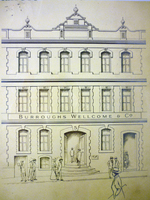
Line drawing of the Burroughs Wellcome & Co. office, Cape Town, South Africa.
-

The expedition carried with them a Tabloid Medicine Chest. On the 11th of March, knowing that the party was unlikely to survive, Scott ordered Edward Wilson, the expedition’s Chief Scientist and a qualified doctor, to divide the painkillers between them so they could each end their life on their own terms. Writing in his diary on that day, Scott states, “I practically ordered Wilson to hand over the means of ending our troubles to us, so that anyone of us may know how to do so".
Scott, Bowers and Oates had thirty opium tabloids apiece and Wilson, the morphine. Scotts diary entry on either the 22nd or 23rd of March showed that they had a change of heart however: “no fuel and only one or two left of food — must be near the end. Have decided that it shall be natural — we shall march for the depot with or without our effects and die in our tracks".
-
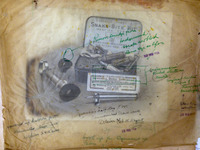
Examples of Wellcome's design changes annotated on tracing paper. 1914–1938. WF/M/I/PR/O01/3, 4, 9, 8. Wellcome Collection.
-
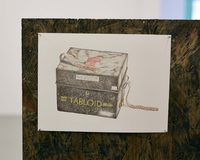
A drawing by the artist-curator James Hutchinson (Chapter Thirteen) based on an audio description of the object as art of the Glasgow International Arts festival.
"Nina Liebenberg also undertakes a form of object analysis at an institutional border. She spent an afternoon in the strongroom of the University of Cape Town's special collections department, examining an early 20th century medicine box commissioned for a hunting trip in (then) Northern Rhodesia. Such boxes had been essential parts of the British colonial project, and allowed emigres, missionaries and explorers to venture deeper into unknown territory without fear of contracting tropical diseases. Liebenberg’s report from the strongroom acts as a set of instructions for The Landis Museum’s curator to make a drawing of the box, to which he has no physical access".
Extract from the 'Exhibition Guide' of the Landis Museum (Chapter Thirteen), Glasgow International Arts Festival, 20 April - 07 May 2018.
-

A page of the Tabloid guide.
-

Georgian silver spoon drawn to the height of Niagara Falls.
-

"An object-study of a grain of rice by the artist Elaine Gan similarly shows the intermingling temporalities of humans, nonhumans and machines through an assemblage of images, text and vectors maps. Gan explores four temporalities within this research – the time of technologies, matter, memory and a calendar year – and installs the work as a long horizontal strip that cannot be viewed in full from a fixed position but encourages the viewer to walk ‘through time, occupy multiple positions’ and in so doing ‘trace new connections’ (Gan 2021). Time-travelling over two thousand years, Rice child (Stirrings) (2011) begins in the Mekong Delta, where the farming of champa rice facilitated the formation of stable settlements. It then follows a selection of rice varieties, revealing how they became technologies that accumulate socio-political formations, and weaves through the 2007/8 food crisis" (Liebenberg 2021: 28).
-

"In Simon Starling’s work, inanimate objects are activated in various ways, especially when their political or economic history is revealed or when their materiality becomes an embodiment of something discovered during his research. His work enables and celebrates diverse interpretations of objects in many instances, as Greenblatt (1991) notes when referring to artistic and curatorial activity, deflecting attention away from the object onto the systems that gave rise to it in the first place. Starling conducts a close inspection of his objects, usually following a web of connections across the globe and across history, which in many of his works lead him back to the starting point; a vintage photograph of a Henry Moore sculpture leads to the production of a bronze sculpture based on the shape of a single enlarged silver particle that makes up the photograph and which, when converted into a sculpture, resembles the biomorphic shapes that served as inspiration for the Moore sculpture in the original vintage photograph ('Silver particle/bronze (after Henry Moore)', 2008). The machinations of its history somehow lost in the image when seen in the museum archive come back into play through the translations and reconstructions encountered in the detour and are materialised in the exhibition format" (Liebenberg 2021: 26 - 28).
-

A pencil was completely shaved by a pencil sharpener into one long continuous spiral.
-
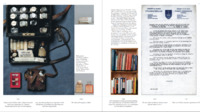
"The caption for the image offered further information about the department in which the medicine chest was located, stating: ‘Black metal travelling medicine chest, containing bottles and packets of medication belonging to Walter Floyd, given to UCT by the Floyd family (Manuscripts and Archives).’
It seemed strange to me that this three-dimensional object would be housed in the Manuscripts and Archives (M&A) department (also known as ‘Special Collections’) of UCT Library, as it hosts collections of ‘printed and audio-visual materials on African studies and a wide array of other specialised subjects, as well as over 1,300 sub-collections of unique manuscripts and personal papers’ (Special Collections 2015). As my italics emphasise, bulkier three-dimensional objects seemed to have no place here.
I nonetheless thought it worthwhile to type the words ‘medicine chest’ into the general library search engine, an application called Ex Libris Primo; the search delivered no results" (Liebenberg 2021: 24).
-

Hiddingh Hall during the construction of the installation of Curiosity CLXXV.
-

Hiddingh Hall prior to the installation of Curiosity CLXXV.
-

"Along with the guides that regulated practices and protocols to stabilise and standardise an individual’s response to unfamiliar and disorienting sights (Kennedy 2013: 42), the gender, class and ethnicity of the observer were also of importance , as was the use of ‘ever more sophisticated instruments and calculations designed to minimize the intrusion of subjectivity into the reporting of information’ (Driver 2001: 55). By regulating who was doing the viewing, stipulating what should be viewed and how and supplying tools to measure these observations, scientific institutions promoted an authoritative ‘way of seeing’ in the field that differentiated the scientific view from that of the ordinary traveller (Driver 2001: 49)" (Liebenberg 2021: 109).
-
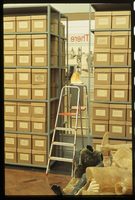
An extract from an email from archaeologist and former head of African Studies, Prof Nick Shepherd (Jan 21, 2021, 11:33 AM):
"Disciplinary practices and regimes of care constitute a kind of bureaucratization or governmentality of elapsed time and its material remains and human relationships, placing these remains and relationships under a kind of administration. We think of the elaborate structure of regional typologies and chronologies, the immense work of correctly assigning artefacts and sites to these imagined categories, and the vast institutional apparatus that supports these endeavors – all of which constitute archaeology as a formidable disciplinary enterprise. In the face of this enterprise, the 'many worlds' of local claims to the past have little chance of success."
-
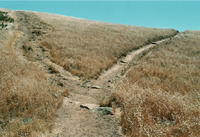
"The processes of digression and diversion have much in common with what the writer Ross Chambers (1999) calls ‘loiterature’. Chambers investigates the digressive, category-blurring genre of writing found in works such as Nicholson Baker’s 'The mezzanine', Paul Auster’s 'City of glass' and Laurence Sterne’s 'Tristam Shandy'. Loiterly writing, according to Chambers, disarms criticism by providing a moving target, shifting as its own divided attention constantly shifts.
Criticism depends on the opportunity to discriminate and hierarchise, determining what is central and what is peripheral (Chambers 1999: 9), which this form eludes by resisting contextualisation or singular categorisation. Loiterature promotes sites of endless intersection, where attention is always divided between one thing and some other thing, always willing and able to be distracted, contrasting ‘the disciplined and the orderly, the hierarchical and the stable, the methodical and the systematic’ (Chambers 1999: 10).
In contrast to methods of science that seek to stabilise objects within taxonomic systems or that require the formulation of hypotheses to provide direction for experimentation and a basis for concrete outcomes, the processes of curatorship and artmaking revel in rerouting and redirecting and in diversion and digression" (Liebenberg 2021: 286).
-

The wall text accompanying these charts in the Hunterian museum, Glasgow, reads: "In the late 19th and 20th centuries, before the advent of colour slides that could be projected, the teaching of Zoology depended heavily on the use of wall charts to illustrate lectures. They were hung on a special pulley system at the front of the lecture theatre and, because of their large size, could be clearly seen from the back of the class".
-
A guide to illnesses common to tropical regions and how to cure them using Burroughs Wellcome & Co.'s products
-

“On two occasions in 1977, when a patient’s left ventricle failed acutely after routine open-heart surgery and when no human donor organ was available, Barnard transplanted an animal heart heterotopically. On the first occasion, a baboon heart was transplanted, but this failed to support the circulation sufficiently, the patient dying some six hours after transplantation. In the second patient, a chimpanzee heart successfully maintained life until irreversible rejection occurred four days later, the recipient’s native heart having failed to recover during this period. Further attempts at xenotransplantation were abandoned and even now, more than 30 years later, xenotransplantation remains an elusive holy grail despite decades of research.”
Extract: Brink JG, Hassoulas J. The first human heart transplant and further advances in cardiac transplantation at Groote Schuur Hospital and the University of Cape Town. Cardiovasc J Afr. 2009; 20(1):31-5
-
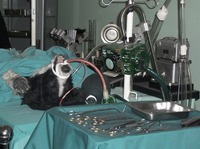
The guided tour of the museum, which commemorates the first heart transplant performed by Chris Barnard in 1967, starts with a representation of the car accident that provided the heart for the transplant, through to the animal lab where Barnard conducted experiments with over 50 dogs to perfect the technique of heart transplantation. From there one can tour a model of Denise Darvall's bedroom and Christiaan Barnard's office before seeing a recreation of the surgery in the actual operating theaters where it occurred.
-
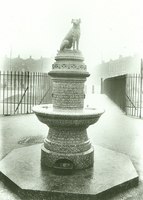
On Feb. 2, 1903, English physicians William Bayliss and Ernest Starling, gave a lecture on the digestive system to a theatre full of medical students. Also in attendance were Lizzy Lind af Hageby and Leisa Schartau, committed feminists and anti-vivisectionists. They had travelled from Sweden to enrol at the London School of Medicine for Women, attend lectures around town, and document the practice of vivisection in British universities.
During the lecture, a brown terrier was wheeled out, strapped to a board. Starling had already performed one experiment on the dog two months earlier, shutting off its pancreas. This time, Bayliss cut open the dog’s neck and spent half an hour unsuccessfully trying to stimulate the animal’s salivary glands with electrodes. Eventually, he gave up and handed the dog over to a student (Henry Dale, another future Nobel laureate) who stabbed it through the heart, thus ending the lesson.
What followed was a court case filed by Stephen Coleridge, a prominent barrister and secretary of the National Anti-Vivisection Society against Bayliss. After four days of testimony, the judge called the women’s account “hysterical” while giving instructions to the jury. The jurors conferred for 20 minutes, then found Coleridge guilty of libel.
Anti-vivisectionists commissioned a bronze statue of the dog as a memorial, unveiled in Battersea in 1906. Its plague, which read "Men and women of England, how long shall these Things be?" led to the it being vandalised on a frequent basis. On 10 December 1907, hundreds of medical students marched through central London waving effigies of the brown dog on sticks, clashing with suffragettes, trade unionists and 300 police officers, one of a series of battles known as the ‘Brown Dog’ riots.
In March 1910, tired of the controversy, Battersea Council sent four workers accompanied by 120 police officers to remove the statue under cover of darkness, after which it was reportedly melted down by the council's blacksmith.
-
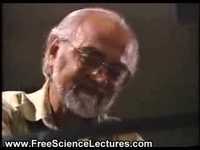
In 1999, Jaak Panksepp and Jeffrey Burgdorf successfully demonstrated that tickling young rats spurs them into letting out the same ultrasonic giggles they make during play.
-

Cyanotype on paper. Ink on perspex.
The work shows the exact positioning of the stars from J.M. Barrie’s window at 3 Adelphi Terrace, London (51°30'N 0°7'21"W), on Saturday, 19 June 1937 – the night of his death. Based on the direction of his window, I was able to locate the ‘second star to the right’ at the 45 degree angle he would have stood and viewed the night sky. Hopefully, he reached his destination, after departing the flat and traveling ‘straight on till morning’.
-

Marine biologists studying whalesharks use the pattern-recognition technique, developed in 1986, that astronomers use to analyze data from the Hubble Space Telescope. Studying the spatial relationships between a whaleshark's spots form the basis for creating a unique identifier for each shark.
-

Published in 1841, Jackson’s guide was the first of a series of guides published during this period which offered notes for the traveller on appropriate conduct in the field – from providing methods for training the eye to observe what was deemed as relevant details, to instructions on which precision instruments should be carried and how to use them to record and inscribe the results of observations made (Withers 2013: 170). As Jackson states, his guide pointed out to the “uninitiated Traveller what he [sic] should observe, and to remind the one who is well informed, of many objects which (…) might escape him” (Jackson 1841: i).
-

In 2015, Conservation International scientists in Indonesia attached satellite transmitters to the dorsal fins of whale sharks to learn more about their migratory movements and diving behavior. Dipsy, a 4.57-meter male, spent much of his 17-month deployment in Triton Bay but also visited the Aru and Kei Islands – one of our first Kaimana whale sharks to explore the Arafura Sea – before returning to Kaimana. He hit a maximum depth of 625 meters.
-

In 2015, Conservation International scientists in Indonesia attached satellite transmitters to the dorsal fins of whale sharks to learn more about their migratory movements and diving behavior. Yoda had a lengthy 26-month deployment, spending all of that time in Cendrawasih Bay. The 4.83-meter male dove to a maximum depth of 1,375 meters, reaching the bottom of the bay at one of its deepest points.
-

In 2015, Conservation International scientists in Indonesia attached satellite transmitters to the dorsal fins of whale sharks to learn more about their migratory movements and diving behavior. At just 3 meters in length (about 10 feet), Fijubeca logged an impressive 9,000 kilometers (5,592 miles) during his deployment. He visited eight of the Bird’s Head Seascape's marine protected areas (MPAs), reaffirming the placement of MPAs as related to megafauna migratory routes.
-

In 2015, Conservation International scientists in Indonesia attached satellite transmitters to the dorsal fins of whale sharks to learn more about their migratory movements and diving behavior. Sunbridge was one of our first sharks tagged in Saleh Bay, Sumbawa, where he spent his entire 14-month deployment. Though this 6.23-meter male spent a fair bit of time on the surface, he frequently visited the bay's bottom at a maximum depth of 350 meters.
-

In 2015, Conservation International scientists in Indonesia attached satellite transmitters to the dorsal fins of whale sharks to learn more about their migratory movements and diving behavior. Sebastian spent most of his 27-month deployment in Cendrawasih Bay but also recorded a visit to the Mapia atoll and ventured past Biak into PNG coastal waters. He eventually returned to Cendrawasih, where his tag's battery expired, having logged a maximum dive of 1,125 meters.
-

The Brazilian artist Lygia Clark (1920-1988) produced relational objects to be inhabited and activated by groups of people. Her net made up of elastic bands attached to each other, allows a complex structure, a complex grid, inviting a choreographed dance between strangers as they play with it by pushing and pulling these bands.
-

"Early Pacific seafarers did not have scientific instruments or conventional European-style maps to voyage to, and settle, the thousands of islands of Micronesia and Polynesia. Instead they used the movement of the sea, the direction of the wind, the position of the sun and stars, and the flight of birds. This is a navigation chart, obtained by Georg Irmer, the Governor of the Marshall Islands from Chief Nalu of Jaluit atoll in 1896. The strips of wood, bound by cane, represent the currents and winds, and the six small, white shells represent islands".
-

Captain Scott writes in his den in the Terra Nova hut in this October 7, 1911.



















































